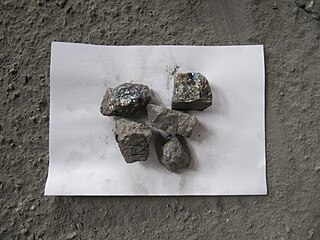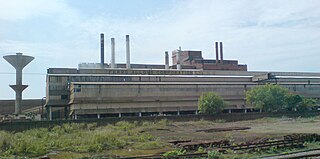
Tungsten, or wolfram, is a chemical element with the symbol W and atomic number 74. Tungsten is a rare metal found naturally on Earth almost exclusively as compounds with other elements. It was identified as a new element in 1781 and first isolated as a metal in 1783. Its important ores include scheelite and wolframite, the latter lending the element its alternate name.

Group 6, numbered by IUPAC style, is a group of elements in the periodic table. Its members are chromium (Cr), molybdenum (Mo), tungsten (W), and seaborgium (Sg). These are all transition metals and chromium, molybdenum and tungsten are refractory metals.

Armour-piercing ammunition (AP) is a type of projectile designed to penetrate either body armour or vehicle armour.

Armour-piercing discarding sabot (APDS) is a type of spin-stabilized kinetic energy projectile for anti-armour warfare. Each projectile consists of a sub-calibre round fitted with a sabot. The combination of a lighter sub-calibre projectile with a full-calibre propellant charge allows for an increase in muzzle velocity compared to full-calibre rounds, giving the round increased armour-penetration performance. To further enhance their armour-penetration capabilities, APDS rounds typically feature a hardened core made from tungsten or another hard, dense material.
Elkem is a company that produces silicones, silicon, alloys for the foundry industry, carbon and microsilica, and a global provider of advanced material solutions, with more than 6,800 employees and 29 production sites worldwide.

Zestafoni or Zestaponi is the administrative center of Zestafoni District in Western Georgia. Zestafoni is the center of an ancient, historical part of Georgia – Margveti, which is a part of Imereti province. Zestafoni is the center of Margveti's Eparchy of the Georgian Orthodox Church. Zestafoni is situated in the furthest east of the Colchis Plateau, and is built on both banks of the Qvirila River.

Ferromanganese is a ferroalloy with high manganese content (high-carbon ferromanganese can contain as much as 80% Mn by weight). It is made by heating a mixture of the oxides MnO2 and Fe2O3, with carbon (usually as coal and coke) in either a blast furnace or an electric arc furnace-type system, called a submerged arc furnace. The oxides undergo carbothermal reduction in the furnaces, producing the ferromanganese. Ferromanganese is used as a deoxidizer for steel.

Ferrochrome, or ferrochromium (FeCr) is a type of ferroalloy, that is, an alloy of chromium and iron, generally containing 50 to 70% chromium by weight.
Ferroalloy refers to various alloys of iron with a high proportion of one or more other elements such as manganese (Mn), aluminium (Al), or silicon (Si). They are used in the production of steels and alloys. The alloys impart distinctive qualities to steel and cast iron or serve important functions during production and are, therefore, closely associated with the iron and steel industry, the leading consumer of ferroalloys. The leading producers of ferroalloys in 2014 were China, South Africa, India, Russia and Kazakhstan, which accounted for 84% of the world production. World production of ferroalloys was estimated as 52.8 million tonnes in 2015.

Ferrocerium is a synthetic pyrophoric alloy of "mischmetal" hardened by blending in oxides of iron and / or magnesium. When struck with a harder material, the mixture produces hot sparks that can reach temperatures of 3,315 °C (6,000 °F) when rapidly oxidized by the process of striking the rod: Striking both scrapes fragments off, exposing them to the oxygen in the air, and easily ignites them by friction heat, due to cerium's remarkably low ignition temperature ~170 °C (338 °F).

Ferrosilicon is an alloy of iron and silicon with a typical silicon content by weight of 15–90%. It contains a high proportion of iron silicides.

The Ferro Alloys Corporation Limited (FACOR) was floated in 1955 by the house of Sarafs and Mors to become the first major producer of ferromanganese in India.
Ferro molybdenum is an important iron-molybdenum metal alloy, with a molybdenum content of 60-75% It is the main source for molybdenum alloying of HSLA steel.

Zestafoni is a municipality of Georgia, in the region of Imereti. The municipality covers a total area of 423 square kilometres and as of 2014 it had a population total of 57,628 people. Its main town is Zestafoni which is an important industrial center, with a large ferro-alloy plant processing manganese ore from nearby Chiatura. The municipality is a notable wine-growing region.

Nikopol Ferroalloy Plant is a producer of Manganese Ferroalloy and related material located in Ukraine.
Copper–tungsten is a mixture of copper and tungsten. As copper and tungsten are not mutually soluble, the material is composed of distinct particles of one metal dispersed in a matrix of the other one. The microstructure is therefore rather a metal matrix composite instead of a true alloy.
Ferrouranium, also called ferro-uranium, is a ferroalloy, an alloy of iron and uranium, after World War II usually depleted uranium.
Chandrapur Ferro Alloy Plant also known as Maharashtra Elektrosmelt Ltd (MEL), it became a Unit of SAIL in year 2011. Chandrapur Ferro Alloy Plant is the only Public sector Unit engaged in production of Manganese based Ferro Alloys in the Country. The plant is situated at Chandrapur (Maharashtra). It is located 166 km away from Nagpur on Delhi-Chennai rail route and is well connected by rail & road to the major cities of India.
Ferroaluminum (FeAl) is a ferroalloy, consisting of iron and aluminium. The metal usually consists of 40% to 60% aluminium and applications of ferroaluminum include the deoxidation of steel, hardfacing applications, reducing agent, thermite reactions, AlNiCo magnets, and alloying additions to welding wires and fluxes. The alloy is also known for the ability to manufacture low melting point alloys and its ability to carry out aluminothermic welding. Ferroaluminum does not currently have a CAS Registry Number. The presence of iron in aluminum helps in the decrease of casting defects, improves tensile, yield, hardness, and maintains strength at high temperatures. The first recorded usage of the word "ferroaluminum" was in 1887. Ferroaluminum can also be nitrided, as the aluminium bonds well with the nitrogen forming a hard case. The aluminum provided in the alloy helps with this process. The majority of the world's ferroaluminum is produced by Australia, China, Russia, the US and Canada, with the cost of electricity being the main factor in the aluminium obtaining process.










